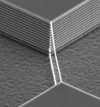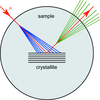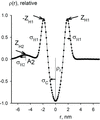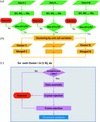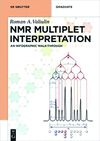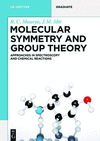issue contents
February 2020 issue

Cover illustration: An example application of the BornAgain software [Pospelov et al. (2020). J. Appl. Cryst. 53, 262-276]. Polarized GISANS from vertically magnetized spherical nanoparticles on top of a substrate. The two simulations correspond to scattering (top) without and (bottom) with spin flip, assuming perfect vertical beam polarization and perfect polarization analysis.
research papers
This paper presents results of molecular dynamics simulations of gold nanoparticles and their experimental verification by means of X-ray diffraction. The conducted studies reveal that structural disorder in gold nanoclusters is related to surface effects and vacancies.
Download citation


Download citation


Open  access
access
 access
accessIt is shown that it is possible to perform combined X-ray and neutron single-crystal studies in the same diamond anvil cell. The data processing procedures and a joint structural refinement of the high-pressure synchrotron and neutron single-crystal data are presented and discussed for the first time.
The background field arising from neutron-beam scattering from reflectometry liquid cells is calculated and compared with experimental measurements. Use of the entire background field for background subtraction in neutron reflectometry measurements represents a significant improvement in accuracy and reduction of measurement uncertainty.
With cross-analysis of electron and X-ray diffraction results, a cylindrically confined hierarchical assembly of molecular chains, unit cells, hydrogen-bonded sheets and lamellae is demonstrated in the triclinic α-phase crystals of nylon 6,12.
A simple full-pattern refinement model has been developed to study Fe–Mn-based alloys. The model can be used to extract accurate lattice parameters from a single X-ray diffraction measurement of a textured multiphase sample.
A sample-delivery method for serial crystallography is introduced, which uses a capillary and a viscous medium.
The isotropic point of a uniaxial bianisotropic mixed crystal is shifted by controlling the concentration of an anion impurity in a solid-solution series. A tunable set of iso-index bandpass filters is proposed.
Open  access
access
 access
accessA multiscale analytical approach is presented for understanding the structure of micro- and nano-fabricated nanowire-based sensors. Using scanning X-ray diffraction microscopy, crystal deformation is evaluated with respect to lattice strain and tilt caused by the manufacturing process of a silicon monolith.
Open  access
access
 access
accessA 2D method employing whole (or part) Debye–Scherrer rings has been used to obtain a more accurate and reliable strain-mapping result for high-density thermal barrier coatings. The method has other applications, but the use of very high energy synchrotron light makes the study of a highly anisotropic microstructure more tractable.
Open  access
access
 access
accessStacking faults and interstratification faults in a cobalt- and aluminium-bearing nickel layered double hydroxide used as a precursor for Li(Ni1−x−yCoxAly)O2 battery materials were quantified by a combination of a grid-search approach and a recursive routine for generating and averaging supercells of stacking-faulted layered substances implemented in the TOPAS software.
Open  access
access
 access
accessA method to analyse neutron Larmor diffraction data from polycrystalline samples is presented.
A method for determining the full deformation tensor from a scanning nano X-ray diffraction experiment mapping two Bragg peaks is described.
A direct comparison is made between electron backscatter diffraction and near-field high-energy diffraction microscopy measurements. A small gold oligocrystal is characterized, and reconstructed orientations and grain-boundary positions are evaluated.
Van der Waals corrected density-functional-theory computations predict a new tetragonal (P4m2) equilibrium crystal structure for nickel hexacyanoferrate, an F43m-structured Prussian blue analogue.
The methods used to estimate chord-length distributions from small-angle scattering data assume a structure made up of spatially uncorrelated and convex regions. Significant errors follow from applying these methods outside of their range of validity.
Experimental considerations for quantitative depth-resolving operando X-ray scattering measurements in a radial transmission geometry are identified.
Open  access
access
 access
accessGrazing-incidence small-angle X-ray scattering coupled with computed tomography (CT) has enabled the visualization of the spatial distribution of nanostructures in thin films. In this study, to optimize the CT image quality, total variation regularization is introduced to minimize sinogram image noise and artifacts.
Open  access
access
 access
accessUsing pair distribution function analysis, the structure of amorphous supported molybdenum oxides is characterized using a new automated data modelling approach.
A robust statistical methodology is described whereby Bragg diffraction is separated from the total scattering without altering the underlying diffuse scattering. Subsequent evaluation of the diffuse scattering by pair distribution function methods reveals unprecedented detail on the system's real structure.
Multi-wavelength Bragg coherent X-ray diffraction imaging is demonstrated on a single Au particle. The reconstructed Bragg electron density and phase field are in excellent agreement with the results obtained from conventional rocking scans of the same particle.
Open  access
access
 access
accessIn this work, a new method is developed to reconstruct the orientation distribution function from experimental data with a set of equally weighted orientations. It is based on the deterministic integer approximation method, but it minimizes the shortcomings of this method by optimizing the orientation grid and kernel function.
A wavelength-resolved neutron tomography study is performed on a reference sample made of several polycrystalline materials, namely nickel, iron, titanium, lead, copper and aluminium. Wavelength-resolved total cross sections for each material and for each voxel in the reconstructed volume of the sample were retrieved.
Open  access
access
 access
accessThis paper describes a method to quantify nanoparticles in clays and soils with small-angle X-ray scattering.
Open  access
access
 access
accessLithium-ion half-cells are studied in situ and operando by small-angle neutron scattering. The variation in the signal can be explained by the lithiation of graphite in the sample.
short communications
The stress-induced C14→C15 phase transformation in an individual nanophase was explored by means of the transmission electron microscopy technique.
computer programs
Open  access
access
 access
accessAn overview of Mercury 4.0, an analysis, design and prediction platform that acts as a hub for the entire Cambridge Structural Database software suite, is presented.
The use of the BILMIX program to model small-angle X-ray scattering data of model membranes and deliver a description of the lipid bilayer electron density and vesicle size distribution is presented.
Multifitting, a computer program designed specifically for modeling the optical properties of multilayer films over a wide range of wavelengths, is described. The key features of Multifitting are the ability to work simultaneously with an arbitrary number of experimental curves and an ergonomic graphical user interface that is designed for intensive daily use in the diagnosis of thin films.
The pipeline IPCAS (Iterative Protein Crystal structure Automatic Solution) integrates the direct-method program OASIS and other protein crystallography programs for experimental phasing and model building, with emphasis on direct-method single-wavelength anomalous diffraction/single isomorphous replacement phasing and direct-method-aided partial-structure extension.
Open  access
access
 access
accessBornAgain is a free and open-source multi-platform software framework for simulating and fitting X-ray and neutron reflectometry, off-specular scattering, and grazing-incidence small-angle scattering (GISAS). This paper concentrates on GISAS.
Open  access
access
 access
accessA Python program to assemble radiation-damaged and partial diffraction data sets from microcrystals is described.
A computer program has been developed for aligning one or two crystal directions in crystals of arbitrary orientation and structure with the coordinate system of a scanning electron microscope. The crystal alignment is globally optimized even for highly constrained cases and may support the microscopy analysis of anisotropic properties, establishment of specific diffraction conditions and preparation of pre-aligned electron-transparent lamellae.
laboratory notes
A simple sample-changing robot has been designed and built for combinatorial studies using grazing-incidence scattering.
The design of sample-positioning probes used in top-loading cryostats is investigated in order to optimize sample cool-down time.
addenda and errata
Free 

crystallographers
Free 

Free 

Free 

book reviews
Free 

Free 



 journal menu
journal menu



















